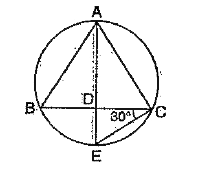In a bisector of angle C meets the side AB at D and circumcricle at E. The maximum value of CD . DE is equal to
none of these
To solve the problem, we need to find the maximum value of the product CD⋅DE where D is the point where the angle bisector of ∠C meets side AB and E is the point where the angle bisector intersects the circumcircle of triangle ABC.
1. Understanding the Geometry:
We have triangle ABC with angle C. The angle bisector of ∠C intersects side AB at point D and the circumcircle of triangle ABC at point E.
2. Using the Power of a Point Theorem:
According to the power of a point theorem, for point D on line AB and the circle, we have:
AD⋅DB=CD⋅DE
This means that the product of the segments created by point D on line AB is equal to the product of segments CD and DE.
3. Maximizing CD⋅DE:
To find the maximum value of CD⋅DE, we need to maximize AD⋅DB.
4. Applying the AM-GM Inequality:
By the Arithmetic Mean-Geometric Mean (AM-GM) inequality:
AD+DB2≥√AD⋅DB
Thus, we can say:
AD⋅DB≤(AD+DB2)2
5. Setting the Lengths:
Let AD+DB=c. Then we have:
AD⋅DB≤(c2)2=c24
6. Conclusion:
Therefore, substituting back into our earlier equation:
CD⋅DE≤c24
The maximum value of CD⋅DE occurs when AD=DB, leading to:
Maximum value of CD⋅DE=c24
Final Answer:
The maximum value of CD⋅DE is c24.
---
We have triangle ABC with angle C. The angle bisector of ∠C intersects side AB at point D and the circumcircle of triangle ABC at point E.
According to the power of a point theorem, for point D on line AB and the circle, we have:
AD⋅DB=CD⋅DE
This means that the product of the segments created by point D on line AB is equal to the product of segments CD and DE.
To find the maximum value of CD⋅DE, we need to maximize AD⋅DB.
By the Arithmetic Mean-Geometric Mean (AM-GM) inequality:
AD+DB2≥√AD⋅DB
Thus, we can say:
AD⋅DB≤(AD+DB2)2
Let AD+DB=c. Then we have:
AD⋅DB≤(c2)2=c24
Therefore, substituting back into our earlier equation:
CD⋅DE≤c24
The maximum value of CD⋅DE occurs when AD=DB, leading to:
Maximum value of CD⋅DE=c24
The maximum value of CD⋅DE is c24.
Topper's Solved these Questions
- PROPERTIES OF TRIANGLES AND CIRCLES CONNECTED WITH THEMBook:OBJECTIVE RD SHARMAChapter:PROPERTIES OF TRIANGLES AND CIRCLES CONNECTED WITH THEMExercise:SOLVED MCQ
Explore 2 Videos
- PROPERTIES OF TRIANGLES AND CIRCLES CONNECTED WITH THEMBook:OBJECTIVE RD SHARMAChapter:PROPERTIES OF TRIANGLES AND CIRCLES CONNECTED WITH THEMExercise:Section II - Assertion Reason Type
Explore 13 Videos
- PROPERTIES OF TRIANGLES AND CIRCLES CONNECTED WITH THEMBook:OBJECTIVE RD SHARMAChapter:PROPERTIES OF TRIANGLES AND CIRCLES CONNECTED WITH THEMExercise:Chapter Test
Explore 55 Videos
- PLANE AND STRAIGHT LINE IN SPACE Book:OBJECTIVE RD SHARMAChapter:PLANE AND STRAIGHT LINE IN SPACE Exercise:Chapter Test
Explore 31 Videos
- REAL FUNCTIONS Book:OBJECTIVE RD SHARMAChapter:REAL FUNCTIONS Exercise:Chapter Test
Explore 60 Videos
Similar Questions
In ΔABC with fixed length of BC , the internal bisector of angle C meets the side AB at D and meet the circumcircle at E. The maximum value of CD×DE is
View SolutionIn ABC with fixed length of BC, the internal bisector of angle C meets the side ABatD and the circumcircle at E . The maximum value of CDxDE is c2 (b) c22 (c) c24 (d) none of these
View Solution
Knowledge Check
In a triangle ABC, angle bisector of ∠BAC cut the side BC at D and meet the circumcircle of ΔABC at E , then find AB .AC+DE. AE.
A2AEBAE2C2AE2D3AE2In a triangle ABC, angle bisector of ∠BAC cut the side BC at D and meet the circumcircle of ΔABC at E. If AC = 4 cm, AD = 5 cm, DE = 3 cm. Find the length of AB.
A10 cmB9.6 cmC12 cmD9 cmIn the triangle ABC, the internal bisector of angle A meets the side BC at D. If BD=7.5 cm and BC=9 cm. Then calculate the value of AB:AC.
A2 :1B1 :2C5 :1D1 :3
In ΔABC, the bisector of the angle A meets the sides BC at D and the circumscirbed circle at E. Prove that DE=a2sec.A22(b+c)
View SolutionIn a triangle ABC, angle bisector of ∠BAC cut the side BC at D and meet the circumcircle of ΔABC at E. If AC = 4 cm, AD = 5 cm, DE = 3 cm. Find the length of AB.
View SolutionIn triangle ABC,∠C=2π3andCD is the internal angle bisector of ∠C meeting the side AB at D. If Length CD is 1, then H.M. of aandb is equal to : (a) 1 (b) 2 (c) 3 (d) 4
View SolutionIn a triangle ABC, angle bisector of ∠BAC cut the side BD and meet the circumcircle of ΔABC at E. If AC = 4 cm, AD = 5 cm, DE = 3 cm. Find the length of AB.
View SolutionIn the given figure, ΔABC is inscribed in a circle and the bisector of ∠A meets BC in D and the circle in E. If ∠ECD=30∘, what is ∠A ?

View Solution
